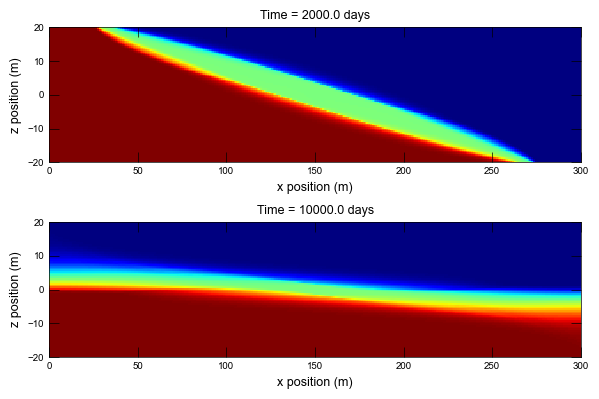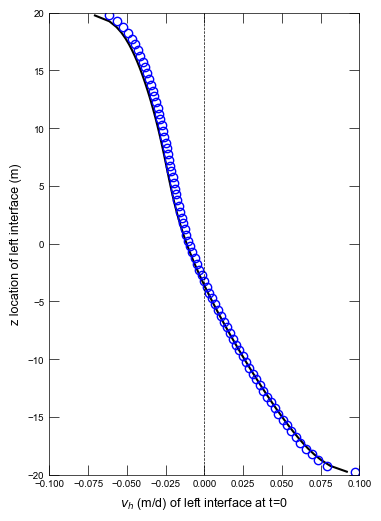This page was generated from
ex-gwt-rotate.py.
It's also available as a notebook.
Rotating interface example
This example demonstrates density-driven groundwater flow.
Initial setup
Import dependencies, define some variables, and read settings from environment variables.
[1]:
import os
import pathlib as pl
from pprint import pformat
import flopy
import git
import matplotlib.pyplot as plt
import numpy as np
from flopy.plot.styles import styles
from modflow_devtools.misc import get_env, timed
# Example name and workspace paths. If this example is running
# in the git repository, use the folder structure described in
# the README. Otherwise just use the current working directory.
sim_name = "ex-gwt-rotate"
try:
root = pl.Path(git.Repo(".", search_parent_directories=True).working_dir)
except:
root = None
workspace = root / "examples" if root else pl.Path.cwd()
figs_path = root / "figures" if root else pl.Path.cwd()
# Settings from environment variables
write = get_env("WRITE", True)
run = get_env("RUN", True)
plot = get_env("PLOT", True)
plot_show = get_env("PLOT_SHOW", True)
plot_save = get_env("PLOT_SAVE", True)
gif_save = get_env("GIF", True)
Define parameters
Define model units, parameters and other settings.
[2]:
# Model units
length_units = "meters"
time_units = "days"
# Model parameters
nper = 1 # Number of periods
nstp = 1000 # Number of time steps
perlen = 10000 # Simulation time length ($d$)
length = 300 # Length of box ($m$)
height = 40.0 # Height of box ($m$)
nlay = 80 # Number of layers
nrow = 1 # Number of rows
ncol = 300 # Number of columns
system_length = 150.0 # Length of system ($m$)
delr = 1.0 # Column width ($m$)
delc = 1.0 # Row width ($m$)
delv = 0.5 # Layer thickness
top = height / 2 # Top of the model ($m$)
hydraulic_conductivity = 2.0 # Hydraulic conductivity ($m d^{-1}$)
denseref = 1000.0 # Reference density
denseslp = 0.7 # Density and concentration slope
rho1 = 1000.0 # Density of zone 1 ($kg m^3$)
rho2 = 1012.5 # Density of zone 2 ($kg m^3$)
rho3 = 1025.0 # Density of zone 3 ($kg m^3$)
c1 = 0.0 # Concentration of zone 1 ($kg m^3$)
c2 = 17.5 # Concentration of zone 2 ($kg m^3$)
c3 = 35 # Concentration of zone 3 ($kg m^3$)
a1 = 40.0 # Interface extent for zone 1 and 2
a2 = 40.0 # Interface extent for zone 2 and 3
b = height / 2.0
x1 = 170.0 # X-midpoint location for zone 1 and 2 interface
x2 = 130.0 # X-midpoint location for zone 2 and 3 interface
porosity = 0.2 # Porosity (unitless)
# Grid bottom elevations
botm = [top - k * delv for k in range(1, nlay + 1)]
# Solver criteria
nouter, ninner = 100, 300
hclose, rclose, relax = 1e-8, 1e-8, 0.97
Analytical solution
Define an analytical solution for rotating interfaces (from Bakker et al 2004)
[3]:
class BakkerRotatingInterface:
"""
Analytical solution for rotating interfaces.
"""
@staticmethod
def get_s(k, rhoa, rhob, alpha):
return k * (rhob - rhoa) / rhoa * np.sin(alpha)
@staticmethod
def get_F(z, zeta1, omega1, s):
l = (zeta1.real - omega1.real) ** 2 + (zeta1.imag - omega1.imag) ** 2
l = np.sqrt(l)
try:
v = (
s
* l
* complex(0, 1)
/ 2
/ np.pi
/ (zeta1 - omega1)
* np.log((z - zeta1) / (z - omega1))
)
except:
v = 0.0
return v
@staticmethod
def get_Fgrid(xg, yg, zeta1, omega1, s):
qxg = []
qyg = []
for x, y in zip(xg.flatten(), yg.flatten()):
z = complex(x, y)
W = BakkerRotatingInterface.get_F(z, zeta1, omega1, s)
qx = W.real
qy = -W.imag
qxg.append(qx)
qyg.append(qy)
qxg = np.array(qxg)
qyg = np.array(qyg)
qxg = qxg.reshape(xg.shape)
qyg = qyg.reshape(yg.shape)
return qxg, qyg
@staticmethod
def get_zetan(n, x0, a, b):
return complex(x0 + (-1) ** n * a, (2 * n - 1) * b)
@staticmethod
def get_omegan(n, x0, a, b):
return complex(x0 + (-1) ** (1 + n) * a, -(2 * n - 1) * b)
@staticmethod
def get_w(xg, yg, k, rhoa, rhob, a, b, x0):
zeta1 = BakkerRotatingInterface.get_zetan(1, x0, a, b)
omega1 = BakkerRotatingInterface.get_omegan(1, x0, a, b)
alpha = np.arctan2(b, a)
s = BakkerRotatingInterface.get_s(k, rhoa, rhob, alpha)
qxg, qyg = BakkerRotatingInterface.get_Fgrid(xg, yg, zeta1, omega1, s)
for n in range(1, 5):
zetan = BakkerRotatingInterface.get_zetan(n, x0, a, b)
zetanp1 = BakkerRotatingInterface.get_zetan(n + 1, x0, a, b)
qx1, qy1 = BakkerRotatingInterface.get_Fgrid(
xg, yg, zetan, zetanp1, (-1) ** n * s
)
omegan = BakkerRotatingInterface.get_omegan(n, x0, a, b)
omeganp1 = BakkerRotatingInterface.get_omegan(n + 1, x0, a, b)
qx2, qy2 = BakkerRotatingInterface.get_Fgrid(
xg, yg, omegan, omeganp1, (-1) ** n * s
)
qxg += qx1 + qx2
qyg += qy1 + qy2
return qxg, qyg
Model setup
Define functions to build models, write input files, and run the simulation.
[4]:
def get_cstrt(nlay, ncol, length, x1, x2, a1, a2, b, c1, c2, c3):
cstrt = c1 * np.ones((nlay, ncol), dtype=float)
from flopy.utils.gridintersect import GridIntersect
from shapely.geometry import Polygon
p3 = Polygon([(0, b), (x2 - a2, b), (x2 + a2, 0), (0, 0)])
p2 = Polygon([(x2 - a2, b), (x1 - a1, b), (x1 + a1, 0), (x1 - a1, 0)])
delc = b / nlay * np.ones(nlay)
delr = length / ncol * np.ones(ncol)
sgr = flopy.discretization.StructuredGrid(delc, delr)
ix = GridIntersect(sgr, method="structured")
for ival, p in [(c2, p2), (c3, p3)]:
result = ix.intersect(p)
for i, j in list(result["cellids"]):
cstrt[i, j] = ival
return cstrt
def build_models(sim_folder):
print(f"Building model...{sim_folder}")
name = "flow"
sim_ws = os.path.join(workspace, sim_folder)
sim = flopy.mf6.MFSimulation(
sim_name=name,
sim_ws=sim_ws,
exe_name="mf6",
continue_=True,
)
tdis_ds = ((perlen, nstp, 1.0),)
flopy.mf6.ModflowTdis(sim, nper=nper, perioddata=tdis_ds, time_units=time_units)
gwf = flopy.mf6.ModflowGwf(sim, modelname=name, save_flows=True)
ims = flopy.mf6.ModflowIms(
sim,
print_option="ALL",
outer_dvclose=hclose,
outer_maximum=nouter,
under_relaxation="NONE",
inner_maximum=ninner,
inner_dvclose=hclose,
rcloserecord=rclose,
linear_acceleration="BICGSTAB",
scaling_method="NONE",
reordering_method="NONE",
relaxation_factor=relax,
filename=f"{gwf.name}.ims",
)
sim.register_ims_package(ims, [gwf.name])
flopy.mf6.ModflowGwfdis(
gwf,
length_units=length_units,
nlay=nlay,
nrow=nrow,
ncol=ncol,
delr=delr,
delc=delc,
top=top,
botm=botm,
)
flopy.mf6.ModflowGwfnpf(
gwf,
save_specific_discharge=True,
icelltype=0,
k=hydraulic_conductivity,
)
flopy.mf6.ModflowGwfic(gwf, strt=top)
pd = [(0, denseslp, 0.0, "trans", "concentration")]
flopy.mf6.ModflowGwfbuy(gwf, denseref=denseref, packagedata=pd)
head_filerecord = f"{name}.hds"
budget_filerecord = f"{name}.bud"
flopy.mf6.ModflowGwfoc(
gwf,
head_filerecord=head_filerecord,
budget_filerecord=budget_filerecord,
saverecord=[("HEAD", "ALL"), ("BUDGET", "ALL")],
)
gwt = flopy.mf6.ModflowGwt(sim, modelname="trans")
imsgwt = flopy.mf6.ModflowIms(
sim,
print_option="ALL",
outer_dvclose=hclose,
outer_maximum=nouter,
under_relaxation="NONE",
inner_maximum=ninner,
inner_dvclose=hclose,
rcloserecord=rclose,
linear_acceleration="BICGSTAB",
scaling_method="NONE",
reordering_method="NONE",
relaxation_factor=relax,
filename=f"{gwt.name}.ims",
)
sim.register_ims_package(imsgwt, [gwt.name])
flopy.mf6.ModflowGwtdis(
gwt,
length_units=length_units,
nlay=nlay,
nrow=nrow,
ncol=ncol,
delr=delr,
delc=delc,
top=top,
botm=botm,
)
flopy.mf6.ModflowGwtmst(gwt, porosity=porosity)
cstrt = get_cstrt(nlay, ncol, length, x1, x2, a1, a2, height, c1, c2, c3)
flopy.mf6.ModflowGwtic(gwt, strt=cstrt)
flopy.mf6.ModflowGwtadv(gwt, scheme="TVD")
flopy.mf6.ModflowGwtoc(
gwt,
budget_filerecord=f"{gwt.name}.cbc",
concentration_filerecord=f"{gwt.name}.ucn",
concentrationprintrecord=[("COLUMNS", 10, "WIDTH", 15, "DIGITS", 6, "GENERAL")],
saverecord=[("CONCENTRATION", "ALL")],
printrecord=[("CONCENTRATION", "LAST"), ("BUDGET", "LAST")],
)
flopy.mf6.ModflowGwfgwt(
sim, exgtype="GWF6-GWT6", exgmnamea=gwf.name, exgmnameb=gwt.name
)
return sim
def write_models(sim, silent=True):
sim.write_simulation(silent=silent)
@timed
def run_models(sim, silent=True):
success, buff = sim.run_simulation(silent=silent, report=True)
assert success, pformat(buff)
Plotting results
Define functions to plot model results.
[5]:
# Figure properties
figure_size = (6, 4)
def plot_velocity_profile(sim, idx):
with styles.USGSMap() as fs:
sim_ws = os.path.join(workspace, sim_name)
gwf = sim.get_model("flow")
gwt = sim.get_model("trans")
print("Creating velocity profile plot...")
# find line of cells on left side of first interface
cstrt = gwt.ic.strt.array
cstrt = cstrt.reshape((nlay, ncol))
interface_coords = []
for k in range(nlay):
crow = cstrt[k]
j = (np.abs(crow - c2)).argmin() - 1
interface_coords.append((k, j))
# plot velocity
xc, yc, zc = gwt.modelgrid.xyzcellcenters
xg = []
zg = []
for k, j in interface_coords:
x = xc[0, j]
z = zc[k, 0, j]
xg.append(x)
zg.append(z)
xg = np.array(xg)
zg = np.array(zg)
# set up plot
fig = plt.figure(figsize=(4, 6))
ax = fig.add_subplot(1, 1, 1)
# plot analytical solution
qx1, qz1 = BakkerRotatingInterface.get_w(
xg, zg, hydraulic_conductivity, rho1, rho2, a1, b, x1
)
qx2, qz2 = BakkerRotatingInterface.get_w(
xg, zg, hydraulic_conductivity, rho2, rho3, a2, b, x2
)
qx = qx1 + qx2
qz = qz1 + qz2
vh = qx + qz * a1 / b
vh = vh / porosity
ax.plot(vh, zg, "k-")
# plot numerical results
file_name = gwf.oc.budget_filerecord.get_data()[0][0]
fpth = os.path.join(sim_ws, file_name)
bobj = flopy.utils.CellBudgetFile(fpth, precision="double")
kstpkper = bobj.get_kstpkper()
spdis = bobj.get_data(text="DATA-SPDIS", kstpkper=kstpkper[0])[0]
qxsim = spdis["qx"].reshape((nlay, ncol))
qzsim = spdis["qz"].reshape((nlay, ncol))
qx = []
qz = []
for k, j in interface_coords:
qx.append(qxsim[k, j])
qz.append(qzsim[k, j])
qx = np.array(qx)
qz = np.array(qz)
vh = qx + qz * a1 / b
vh = vh / porosity
ax.plot(vh, zg, "bo", mfc="none")
# configure plot and save
ax.plot([0, 0], [-b, b], "k--", linewidth=0.5)
ax.set_xlim(-0.1, 0.1)
ax.set_ylim(-b, b)
ax.set_ylabel("z location of left interface (m)")
ax.set_xlabel("$v_h$ (m/d) of left interface at t=0")
if plot_show:
plt.show()
if plot_save:
fpth = figs_path / f"{sim_name}-vh.png"
fig.savefig(fpth)
def plot_conc(sim, idx):
with styles.USGSMap() as fs:
sim_ws = os.path.join(workspace, sim_name)
gwf = sim.get_model("flow")
gwt = sim.get_model("trans")
# make initial conditions figure
print("Creating initial conditions figure...")
fig = plt.figure(figsize=(6, 4))
ax = fig.add_subplot(1, 1, 1, aspect="equal")
pxs = flopy.plot.PlotCrossSection(model=gwf, ax=ax, line={"row": 0})
pxs.plot_array(gwt.ic.strt.array, cmap="jet", vmin=c1, vmax=c3)
pxs.plot_grid(linewidth=0.1)
ax.set_ylabel("z position (m)")
ax.set_xlabel("x position (m)")
if plot_save:
fpth = figs_path / f"{sim_name}-bc.png"
fig.savefig(fpth)
plt.close("all")
# make results plot
print("Making results plot...")
fig = plt.figure(figsize=figure_size)
fig.tight_layout()
# create MODFLOW 6 head object
cobj = gwt.output.concentration()
times = cobj.get_times()
times = np.array(times)
# plot times in the original publication
plot_times = [
2000.0,
10000.0,
]
nplots = len(plot_times)
for iplot in range(nplots):
time_in_pub = plot_times[iplot]
idx_conc = (np.abs(times - time_in_pub)).argmin()
time_this_plot = times[idx_conc]
conc = cobj.get_data(totim=time_this_plot)
ax = fig.add_subplot(2, 1, iplot + 1)
pxs = flopy.plot.PlotCrossSection(model=gwf, ax=ax, line={"row": 0})
pxs.plot_array(conc, cmap="jet", vmin=c1, vmax=c3)
ax.set_xlim(0, length)
ax.set_ylim(-height / 2.0, height / 2.0)
ax.set_ylabel("z position (m)")
ax.set_xlabel("x position (m)")
ax.set_title(f"Time = {time_this_plot} days")
plt.tight_layout()
if plot_show:
plt.show()
if plot_save:
fpth = figs_path / f"{sim_name}-conc.png"
fig.savefig(fpth)
def make_animated_gif(sim, idx):
from matplotlib.animation import FuncAnimation, PillowWriter
print("Creating animation...")
with styles.USGSMap() as fs:
sim_ws = os.path.join(workspace, sim_name)
gwf = sim.get_model("flow")
gwt = sim.get_model("trans")
cobj = gwt.output.concentration()
times = cobj.get_times()
times = np.array(times)
conc = cobj.get_alldata()
fig = plt.figure(figsize=(6, 4))
ax = fig.add_subplot(1, 1, 1, aspect="equal")
pxs = flopy.plot.PlotCrossSection(model=gwf, ax=ax, line={"row": 0})
pc = pxs.plot_array(conc[0], cmap="jet", vmin=c1, vmax=c3)
def init():
ax.set_xlim(0, length)
ax.set_ylim(-height / 2, height / 2)
ax.set_title(f"Time = {times[0]} seconds")
def update(i):
pc.set_array(conc[i].flatten())
ax.set_title(f"Time = {times[i]} days")
ani = FuncAnimation(fig, update, range(1, times.shape[0], 5), init_func=init)
writer = PillowWriter(fps=50)
fpth = figs_path / "{}{}".format(sim_name, ".gif")
ani.save(fpth, writer=writer)
def plot_results(sim, idx):
plot_conc(sim, idx)
plot_velocity_profile(sim, idx)
if plot_save and gif_save:
make_animated_gif(sim, idx)
Running the example
Define and invoke a function to run the entire scenario, then plot results.
[6]:
def scenario(idx, silent=True):
sim = build_models(sim_name)
if write:
write_models(sim, silent=silent)
if run:
run_models(sim, silent=silent)
if plot:
plot_results(sim, idx)
scenario(0)
Building model...ex-gwt-rotate
run_models took 299824.87 ms
Creating initial conditions figure...
Making results plot...

Creating velocity profile plot...

Creating animation...
